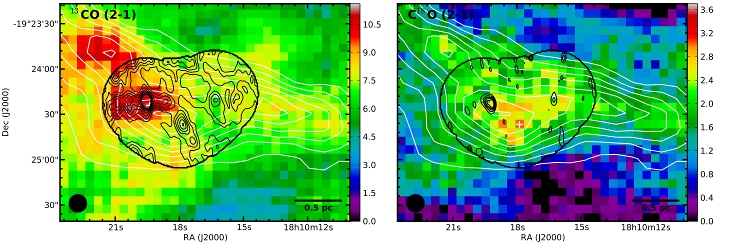| EPoS Contribution |
|
Core kinematics in infrared-dark clouds
Sarah Ragan MPIA, Heidelberg, DE | |
| High-mass stars play an important role in the energy regulation in the Galaxy and in shaping the ISM in which future generations of stars form. Due to the large distances to high-mass star-forming complexes and their precursors known as infrared-dark clouds (IRDCs), high-angular resolution is required to resolve individual cores. As part of the Herschel guaranteed time key program "Earliest Phases of Star Formation (EPoS)" we obtained far-infrared maps of 45 IRDCs at all photometric bands from 70 to 500 microns. Within this cloud sample, we have isolated a population of cores closely following the distribution of dense gas. Modeling their spectral energy distributions, we find that the cores require a central heating source and are thus protostellar in nature. The cores are very cold (20K) and have a range of four orders of magnitude in luminosity. We present a new, multi-tracer IRAM (30-meter and Plateau de Bure) follow-up study relating the internal and environmental kinematics to the core populations in a sample of IRDCs in various evolutionary stages. These observations place important constraints on both the initial conditions of high-mass star formation and the impact of localized and large-scale feedback mechanisms. | |
 | |
| Caption: On the left panel, the color scale shows the integrated intensity of 13CO(2-1) which probes more diffuse gas compared to C18O(2-1), shown in color on the right. Both are in units of K km/s The beam shown in the lower left of each panel is the 11.8'' resolution of the CO observations with the IRAM 30-m. The white contours show the continuum emission of from cold dust in this IRDC at 350 microns, SPIRE observations obtained as part of the EPoS program. The black contours on the left are the combined emission from the N2H+(1-0) transition measured by MOPRA (single dish telescope) and the Plateau de Bure Interferometer. The black contours on the right shows the 3mm continuum measured by the PdBI. The peak of the 13CO emission coincides with the position of the protostar (white cross to the top left) while the C18O emission does not show significant features over this region, with slight increase at the site of a starless core, shown in the central cross. | |
| Collaborators: T. Henning, MPIA, Germany H. Beuther, MPIA, Germany H. Linz, MPIA, Germany |
Suggested Session:
Filaments |

